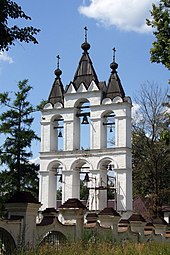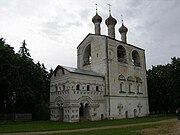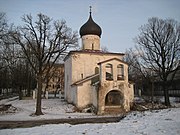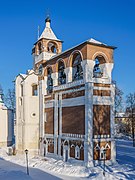Zvonnitsa

Azvonnitsa(Russian:звонница,[1]pl.звонницы,zvonnitsy;Ukrainian:дзвіниця,romanized:dzvinytsia;Polish:dzwonnica parawanowa;Romanian:zvoniţă) is a large rectangular structure containing multiplearchesorbeamsthat supportbells,and a basal platform wherebell ringersstand to perform the ringing using long ropes. It was an alternative to abell towerinRussian,PolishandRomanianmedieval architectural traditions, primarily used inRussian architectureof the 14th–17th centuries. Currently,zvonnitsyare especially widespread in the environs ofPskov.
Unlike bell towers in Western Europe,zvonnitsyin Russia were generally built of brick rather than stone.[2]As a result, they were structurally weaker, which led to new solutions in the 19th-century to address issues with structural support and sufficient suspension of the bells.[2]
Sometimes,zvonnitsywere mounted directly onchurchroofs, resulting in a special form of church called apod zvonom(Russian:под звоном,lit. 'under ringing') orizhe pod kolokoly(иже под колоколы,'under bells'). The most famous example of this type is the Church ofSt Ivan of the Ladder,adjacent toIvan the Great Bell Towerin theMoscow Kremlin.
In Polish, the worddzwonnicarefers to any type of bell tower, while the fortified trellis construction containing apertures for bells is referred to by the termdzwonnica parawanowa.
Examples
[edit]-
Borisoglebsky Monastery,Borisoglebsky, Yaroslavl Oblast
-
Church of St. Nicholas,Pskov-Caves Monastery,Pskov
-
Church of St. George the Victorious,Pskov
-
Assumption Cathedral,Rostov Kremlin,Rostov
See also
[edit]References
[edit]- ^Williams 2014,p. 246, A Russian belfry that is a masonry structure with apertures in which bells are hung from cross beams.
- ^abWilliams 2014,p. 128.
Sources
[edit]- Williams, Edward V. (14 July 2014).The Bells of Russia: History and Technology.Princeton University Press.ISBN978-1-4008-5463-9.
External links
[edit]- Zvonnitsain theGreat Soviet Encyclopedia
- Zvonnitsa in Architectural dictionary
- Zhuravlev Yu. V. Zvonnitsa of Sophia Cathedral
- A. G. Melnik. About zvonnitsa of Borisoglebsky MonasteryArchived2011-10-06 at theWayback Machine
- Churches Under Bells






